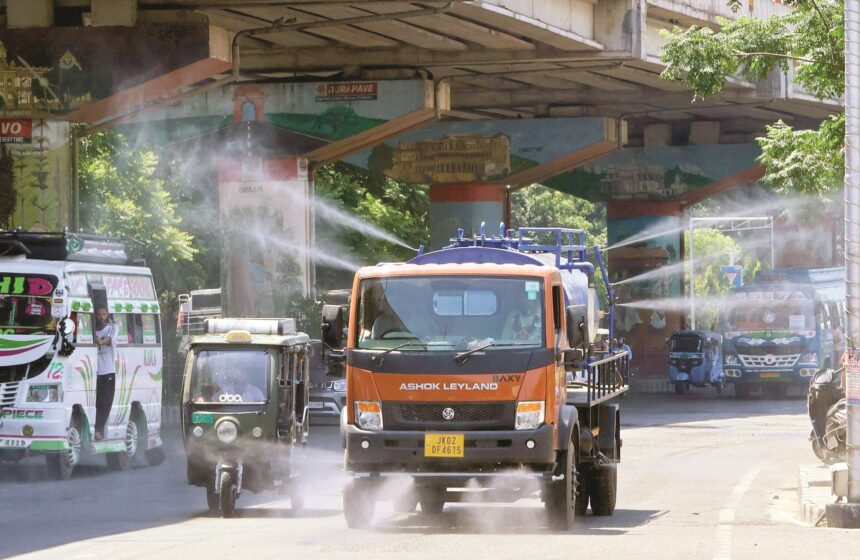• Jammuswelters at 43.6°C, Kathua registers 47.1°C, Srinagar records 32.6°C
• No respite from heat wave in J&K for next 7 days
Srinagar, May 28: The mercury continued its upward trend in Jammu and Kashmir, with no respite from the heatwave expected over the next seven days, according to the local Meteorological Department. Kathua recorded the hottest day of the season so far at 47.1 degrees Celsius, making it the hottest place in the region.
Director of the Meteorological Centre in Kashmir, Dr.Mukhtar Ahmad, informed Rising Kashmir that Kathua reached 47.1 degrees Celsius, while Jammu recorded 43.6 degrees Celsius. He indicated that an isolated heatwave is expected to persist in the plains of the Jammu division for the next five days, with hot and dry weather prevailing in the Kashmir valley and hilly regions of the Jammu division for the next two days.
Dr Mukhtar said there is no respite in heat wave and hot weather conditions over plains of Jammu division during next 7 days.
“There is slight relief from heat wave/Hot & dry weather conditions during 30-31 May and June 1-2 over most parts of Kashmir Division and few hilly areas of Jammu Division,” he added.
Dr Mukhtar said that there will be another spell of heat wave from June3rd to 5th.
“People should avoid heat exposure during 12 noon to 3 pm and drink a lot of fluid and water especially vulnerable people (Elderly people, infants and childrens),” he added.
Analyzing weather data over the past decade, some noteworthy trends and record-breaking figures have been observed. In May 2023, the highest maximum temperature recorded was 42.0°C on the 23rd, while the lowest minimum temperature was 15.8°C on the 10th. May 2022 saw even hotter days, with a peak temperature of 43.9°C on the 15th and a low of 18.2°C on the 24th. May 2021 had the highest 24-hour rainfall in the past decade at 31.8 mm on the 13th, with temperatures ranging between 41.6°C on the 27th and 17.4°C on the 13th.
It said that the highest maximum temperature ever recorded was a scorching 47.4°C on May 26, 1984, while the lowest minimum temperature was 9.8°C on May 13, 1982. The heaviest 24-hour rainfall occurred on May 10, 1987, with 57.3 mm, and the highest monthly total rainfall was 174.6 mm in 1987.
As per MeT data, Srinagar recorded 32.6°C as the maximum temperature and 15.4°C as minimum temperature. Ski resort Gulmarg in north Kashmir recorded a high of 22.4 degrees Celsius and 11.0 as minimum temperatures.
Health resort Pahalgam in south Kashmir recorded 27.8°C as maximum temperature and 9.3°C as the minimum temperature. Kokernag recorded 31.0°C as the maximum temperature, 13.3°C as minimum temperature. Kupwara in north Kashmir recorded maximum temperatures of 30.9°C.
Meanwhile Jammu is witnessing hot and humid weather conditions and recorded at 43.6°C as maximum temperature and 23.6 as minimum temperatures. Katra recorded 39.4°C and 23.4°C as the minimum temperature.
Baramulla, 30.9°C, Bandipora 31.1°C, Budgam 32.0°C, Ganderbal 33.6°C, Pulwama 32.6 °C, Anantnag 31.6 °C, Shopian 31.6°C, Banihal= 31.8°C, Bhaderwah 34.2°C, Batote 32.4°C and Katra 47.1°C.
Last week, Srinagar recorded a high of 31.6°C, marking it as the hottest day of the season and the third warmest May ‘day’ in the past decade for the summer capital.
The MeT spokesman said during the past 10 years from 2014 to 2024, the maximum temperatures in May have ranged from 28.5°C to 31.9°C. Minimum temperatures have varied between 5.0°C and 9.8°C.
As temperatures rise across Kashmir, authorities are on high alert for forest fires. The Jammu and Kashmir Disaster Management Authority (JKDMA) has issued a warning of extreme fire risk for next week. Residents are urged to report fires immediately by dialing 112.
A JKMA spokesman said that the ongoing heat wave, with rising temperatures, low humidity, and dry conditions, has significantly increased the wildfire risk. There is a need for the importance of vigilance and early reporting to prevent fires from spreading and causing extensive damage to the environment, wildlife, and property, he said.
“Authorities are coordinating with the Forest Department and emergency services to ensure a prompt response to any incidents. Public cooperation is essential; people should report any signs of fire or smoke immediately,” the spokesman said.
Kashmir is facing a severe environmental crisis with forest fires threatening the region’s greenery. Dry weather and high temperatures have already destroyed acres of forest land, impacting biodiversity and air quality.








